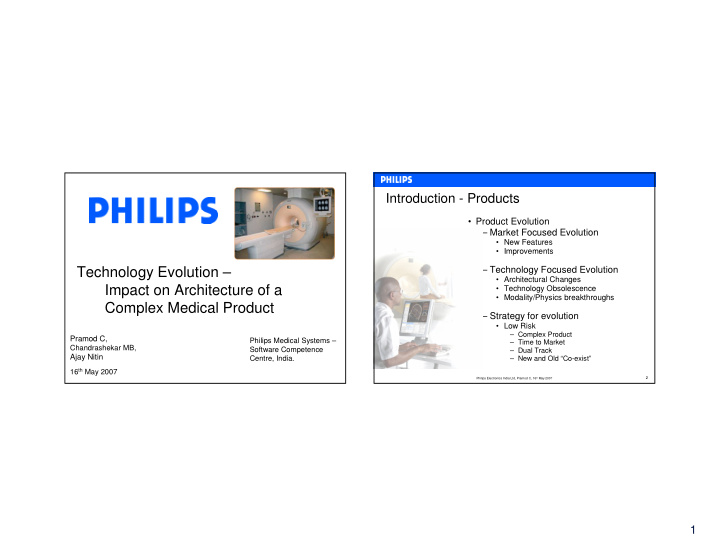



Introduction - Products • Product Evolution – Market Focused Evolution • New Features • Improvements Technology Evolution – – Technology Focused Evolution • Architectural Changes Impact on Architecture of a • Technology Obsolescence • Modality/Physics breakthroughs Complex Medical Product – Strategy for evolution • Low Risk – Complex Product Pramod C, Philips Medical Systems – – Time to Market Chandrashekar MB, Software Competence – Dual Track Ajay Nitin Centre, India. – New and Old “Co-exist” 16 th May 2007 Philips Electronics India Ltd, Pramod C, 16 th May 2007 2 1
Low Risk Approach - Impact Legacy ! • New Functionality A legacy system is an antiquated computer system or application – Typically in newer Technology program which continues to be used because the user (typically an – Unfit to add in old code/design organization) does not want to replace or redesign it. � ��������� � – Middle ground approach • “Let’s reduce the risk” • Outcome The problem… •Legacy represents significant value in terms of investment. Legacy ! •Valuable domain knowlegde embedded in source-code. •Documentation not up-to-date. ������������������������������ ���������������������������������������������������� Philips Electronics India Ltd, Pramod C, 16 th May 2007 3 Philips Electronics India Ltd, Pramod C, 16 th May 2007 4 2
Legacy - Scanner Control Software - Legacy – SC/SD - ScanDefine : � Scan UI + presets • Scan Protocol selection • Scan Protocol modification � Scanner Calibration • Scan Protocol validation � Scanner Diagnostics � Scanner Options � Scanner Status Console ScanControl : • Scan Protocol execution • Delayed Reconstruction • Development tools: Scanner * Sequence Debugger * Scan Batch Interpreter * Control Parameters Workspot Philips Electronics India Ltd, Pramod C, 16 th May 2007 5 Philips Electronics India Ltd, Pramod C, 16 th May 2007 6 3
Legacy – SC/SD / ExamCards - Benefits of ExamCards ScanDefine : • Legacy Functionalities – Still in the old environment switch – Ease of Use ExamCards : • New Functionalities in new – Personalized environment • Basic to Advanced – Standardization • Consistent Image Quality • Clinically validated – User community experience • ExamCards can be shared! – Up to date switch Philips Electronics India Ltd, Pramod C, 16 th May 2007 7 Philips Electronics India Ltd, Pramod C, 16 th May 2007 8 4
ExamCards in Achieva R1 ExamCards in R1 Philips Electronics India Ltd, Pramod C, 16 th May 2007 9 Philips Electronics India Ltd, Pramod C, 16 th May 2007 10 5
Legacy – Some conclusions Lets Take Stock… • New Functionality • Low Risk Approach is OK – Added for various reasons – Typically in new technology – Co-exists with old design • However… – Increasing Cost – Decreasing Flexibility – It Introduces Dual Track • What can be done? – Curtails Future Development – Phase out old functionality – Re-Architect ? – Maintenance Cost Increases • Will Architecture Help ? Look at the system as a set of “Services” offering “end-functionality” Philips Electronics India Ltd, Pramod C, 16 th May 2007 11 Philips Electronics India Ltd, Pramod C, 16 th May 2007 12 6
Advantages of Service Approach Services View of System Applications Scripts • Clear Separation of Concerns Application User Interface (Test, for e.g.) • Each Service – Is “Self Sufficient” Infrastructure Infrastructure Infrastructure “Glue” and Component Component Component Value-addition – Has well defined evolution path Components Infrastructure Infrastructure Component Component • Addition of functionality is easier – Flexible system High Level Service – Can be upgraded by parts Low Level Low Level Layered • Applications and UI can be diverse Service Service Services • Common Architecture for flavors of products HW Abstraction HW Abstraction HW Abstraction Service Service Service • Independent and Geographically divided teams Hardware (Abstraction) – Each Service has an Owner Philips Electronics India Ltd, Pramod C, 16 th May 2007 13 Philips Electronics India Ltd, Pramod C, 16 th May 2007 14 7
The Phase Out Story The Phase out Story • Step 3: Identify Services • Step 1: Define the present situation – A Service provides end functionality – Present Architecture – A Service can be accessed from anywhere – Technology Boundaries • System is also physically broken – Map functionality – Define Interfaces • Draw up an evolution path • Step 4: Derive a PHASED approach • Step 2: Clean up – Identify Legacy – Plan for Phase out Philips Electronics India Ltd, Pramod C, 16 th May 2007 15 Philips Electronics India Ltd, Pramod C, 16 th May 2007 16 8
Our Migration strategy – example - Some Results… Under all conditions the existing functionality must remain operational in each SW release. 2005 2006 2007 SeqDevUI Seq Seq Dev Dev SC EC SC EC PDF PDF PDF PDF PDF PDF Seq Seq EC STT Dev Dev STT STT SE SE PDF PDF Protocol Protocol PDF PDF Scan Protocol -proto- Scheduler SeqDevUI -proto- Define Proto Final version Philips Electronics India Ltd, Pramod C, 16 th May 2007 17 Philips Electronics India Ltd, Pramod C, 16 th May 2007 18 9
Challenges • Identifying “Services” – And its Affinity to a system part • Defining Interfaces – Interfaces are the key ! – Interfaces should not break Questions/Discussion • New functionality • Technology change • Defining roadmaps – For each service – Technology evolution – Product/Feature evolution • May not be suitable for products – With high Turnaround time – At Technological bleeding edge Philips Electronics India Ltd, Pramod C, 16 th May 2007 19 Philips Electronics India Ltd, Pramod C, 16 th May 2007 20 10
11
Recommend
More recommend